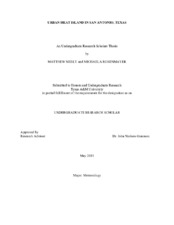| dc.creator | Neely, Matthew Lawrence | |
| dc.creator | Rosenmayer, Michaela | |
| dc.date.accessioned | 2018-05-23T20:38:28Z | |
| dc.date.available | 2018-05-23T20:38:28Z | |
| dc.date.created | 2015-05 | |
| dc.date.issued | 2014-09-26 | |
| dc.date.submitted | May 2015 | |
| dc.identifier.uri | https://hdl.handle.net/1969.1/166549 | |
| dc.description.abstract | Research of the Urban Heat Island (UHI) is an area of continuous investigation for reasons including the potential effects it may have on the living conditions for people, such as increased heat stress. Problems like this will continue to persist in the future because of the continuing trend of increased urbanization across the world. Through data from the COOP network, the San Antonio, Texas area was studied statistically to quantify the magnitude of the UHI. This was achieved by comparing temperature trends before and after the increase of urbanization in this area. For both time periods, differences of mean seasonal temperature values of San Antonio to multiple neighboring cities were calculated. The method used shows the seasons that are most affected, along with removing differences caused by seasonal variation. This study shows that the change of the UHI magnitude over time can be seen most notably in the maximum temperatures. This research can be applied in future studies to quantify the degree urbanization and how it will affect future generations. | en |
| dc.format.mimetype | application/pdf | |
| dc.subject | urban heat island, meteorology | en |
| dc.title | Urban Heat Island in San Antonio, Texas | en |
| dc.type | Thesis | en |
| thesis.degree.department | Atmospheric Sciences | en |
| thesis.degree.discipline | Atmospheric Sciences | en |
| thesis.degree.grantor | Undergraduate Research Scholars Program | en |
| dc.contributor.committeeMember | Nielsen-Gammon, John | |
| dc.type.material | text | en |
| dc.date.updated | 2018-05-23T20:38:29Z | |


